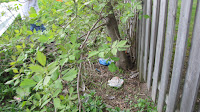by Shelly SargentIt's been a while since we posted here on the blog, and we really do apologise. It's been a hectic early summer for all of us thus far and shows no signs of slowing down any time soon! When casting about for blog topics, I wanted to keep things seasonal, and realised that all I had to do was look outside my window to find a great topic!

Remember this spring - when we were over run by a sea of dandilions? If course, all of us greenies are thoroughly delighted that Ontario has banned pesticides and herbicides. But though this is good news for organic gardeners and great for the environment, it does means that the green manicured lawns of the past are much more difficult (and expensive) to maintain. This is particularly true for those of us who live on larger lots or rural properties with large areas of lawn.
Since xeriscaping (removing lawn and replacing it with drought tolerant plantings and mulch, etc.) didn't seem to be the perfect fit for our situation like it was for some of my friends, I decided to look at other solutions. Now I am a hap-hazard lawn doctor at best: I've never been consistent with fertilizer, and have always hated chemicals (even before it was cool to hate them) - refusing to use them. When we lived in the city, this always meant we'd have a few weeds, but neighbours who sprayed usually kept the weed population at bay. Once we moved to a larger rural property in Caledon, I realized I'd have to get serious about weed management.
A few years ago, I was talking to a neighbour about the encroachment of dandilions and other lawn weeds. This gentleman is one of those people who seems to know a bit about everything and he suggested that I over-seed the larger areas of my lawn with white dutch clover, noting that it is a low growing, mannerly plant that spreads well, and discourages many of the undesireables. It mows like grass, mingles politely with existing grass and looks and smells wonderful in the blooming season.
I liked the idea, particularly when I realized that the bees would also love the clover. Since I knew that bees are the primary source for pollination in any garden and that they need all the support mankind can give them to help bring them back, I figured this could be my small way to help out. So off I went to the local farm supply, told him what I was doing and why and came home with a bag of clover seed.
In retrospect, I likely should have read up on how to sow the seed and when, but I just hand-broadcast the seed onto our lower lawn in mid-June and sat back to see what would happen. Truthfully, in the first year, we had a few patches of clover - which looked a bit messy - and that's about it. It is now the third summer since we over-seeded, and I'm now truly starting to see why a clover lawn is a great thing.
Not only is a clover lawn easy to care for, since it doesn't grow as tall as grass (less mowing), but it is also a natural food for my lawn. Apparently clover used to be a fairly standard addition to most grass seed mixtures because it grew well where soil conditions wouldn't support grass alone. A little online research has also determined that clover (which is a legume, by the way) stores atmospheric nitrogen in little white "nodules" on its roots. When annual clover dies, that nitrogen is released as natural plant food - hey presto: it automatically nourishes your lawn! Nifty! I like anything that saves me a step!
The other day, my dad and I sat on lawn chairs in a sea of white clover, breathing in that sweet, clean smell of clover in bloom and watching the bees busily going about their work amongst the pretty little white flowers, and I realized that all things considered, I'm very happy with my clover/grass lawn. It is very much a work in progress, and I'm still learning how to care for and maintain it. But I really like the way things are heading!
Easy to care for, anti-chemical, supports bees and pollination, resilient and attractive (even with a bunch of kids and a dog running all over it)... to me, clover is the perfect lawn!
 Join the CONVOY to Stop the Melancthon Mega Quarry.
Join the CONVOY to Stop the Melancthon Mega Quarry.
 Starting from Primrose, north on Hwy 124, ending at the Wallace farm - #625007 15 Sideroad, near the proposed Mega
Starting from Primrose, north on Hwy 124, ending at the Wallace farm - #625007 15 Sideroad, near the proposed Mega










